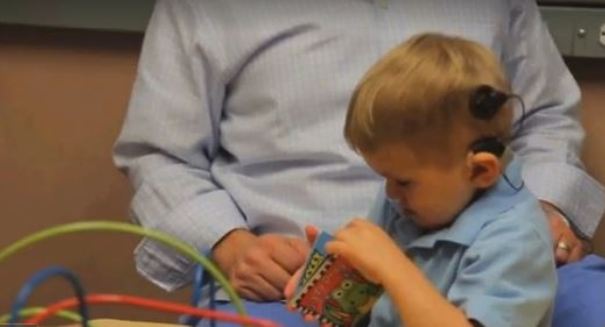
The FDA approved the auditory brain stem implant for clinical trials in children earlier this year.
Three-year old Grayson Clamp, born without a cochlear nerve, became the first child to receive an auditory brain stem implant last month. The implant was successful, shocking young Grayson as he heard sound for the first time, according to a UNC School of Medicine news release.
“We don’t know exactly what it’s like for him,’ the boy’s mother Nicole Clamp told WBTV. “We don’t know exactly what he hears. His brain is still trying organize itself to use sound.”
The cochlear nerve, also known as the acoustic nerve or the auditory nerve, transfers auditory information from the cochlea to the brain. Cochlear implants may be able to remedy some functionality impairments in the cochlear nerve, but are not always successful.
An auditory brain stem implant provides the sensation of hearing where deafness is due to auditory nerve damage. In adults, the most common type of implant is for cases of neurofibromatosis, where tumors grow on nerves such as the cochlear nerve. Bypassing the auditory nerve, if a damaged one exists, or acting as the nerve, if one does not exist, the implant helps the individual detect sounds.
Since Grayson was born without a cochlear nerve, sounds were not being transferred to his brain. His parents tried a cochlear implant when he was younger, but it was unsuccessful. Then, he became one of 10 children selected to participate in a clinical trial for the auditory brain stem implant. In this trial, five children were born without the nerve and five suffered traumatic damage to the nerve.
In the procedure, an external speech processor breaks up sounds and sends their frequency components to an implanted microchip on Grayson’s brain stem. Electrodes are placed on the brain’s cochlear nucleus, where the cochlear nerve would have been. The electrodes are stimulated by information from the external device, allowing Grayson to hear.
According to the Daily Mail, approximately 1,000 people have undergone the procedure, with differing levels of success. In fact, a lot of the recipients of the auditory brain stem implant have an awareness of sound, but may not know what they are actually hearing.
Scientists do not know what Grayson is hearing and hope that the brain will adapt to comprehend the type of sounds he hears. Fortunately, his parents see that Grayson enjoys what he is hearing. They say that he likes the stimulus that sounds provide, but he will need to have speech and hearing therapy to help make this ability functional.
The FDA approved the auditory brain stem implant for clinical trials in children earlier this year. It was the first time the FDA allowed such trials in the U.S. However, similar trials have been conducted outside the U.S., showing promising results. The procedures outside the U.S. have even been successful enough for children with the implants to participate in mainstream classes and curriculum in school.
Leave a Reply